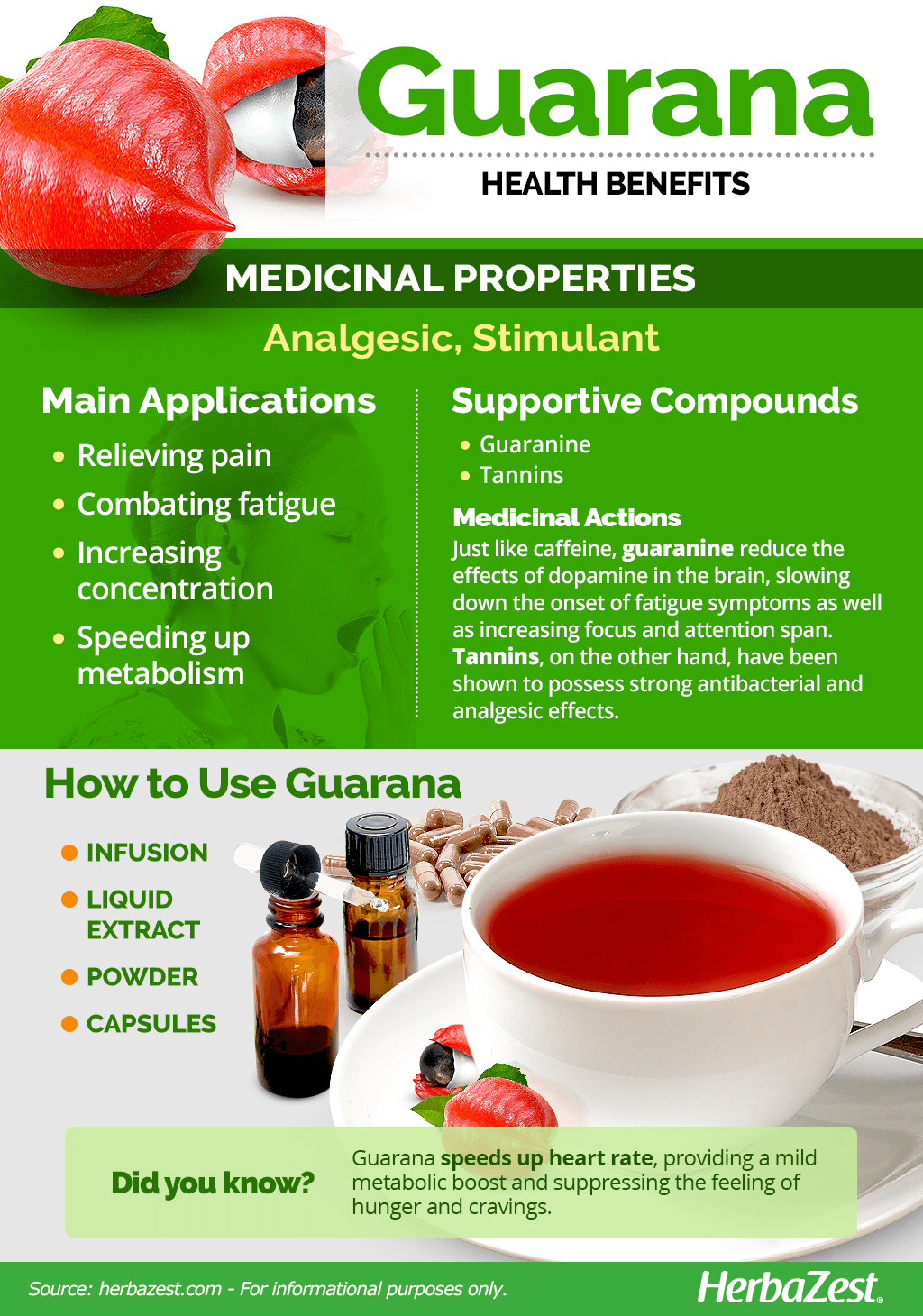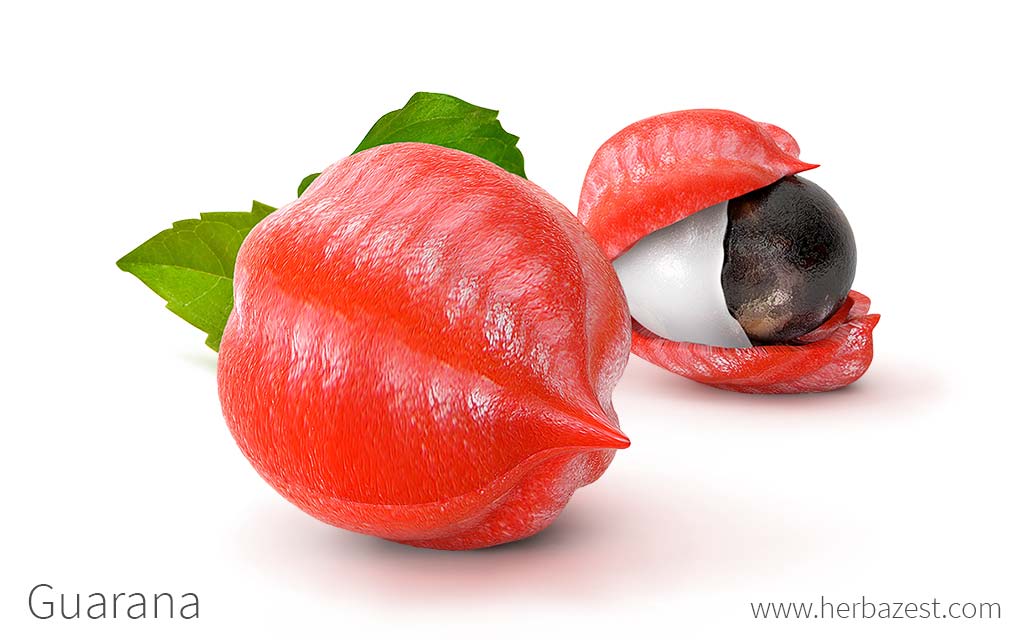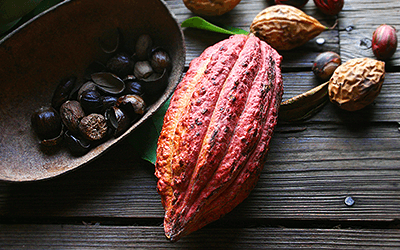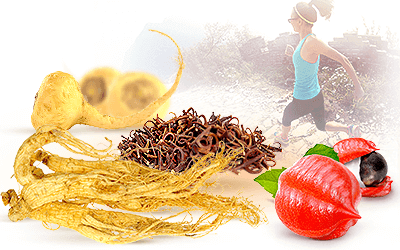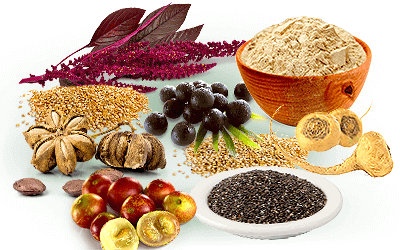Guarana, which originated in the South American jungle, is a climbing plant that has enjoyed popularity in the culinary world for centuries. Its importance can be traced back to the Satere Maue, an Amerindian native tribe belonging to the Guarani-Tupi language family. Its origin was originally explained by them through myth and religious lore, whereby a god offered guarana seeds to villagers as reparation for the murder of a village child at the hands of a more maleficent deity. Ever since, the Satere Maue seem to have relied on the different energizing and brain-enhancing properties of guarana seeds.
Guarana Medicinal Properties
- Medicinal action Analgesic, Stimulant
- Key constituents Guaranine
- Ways to use Capsules, Hot infusions/tisanes, Liquid extracts, Powder
- Medicinal rating (3) Reasonably useful plant
- Safety ranking Use with caution
Health Benefits of Guarana
Guarana has been used for centuries to treat a number of health conditions. Its alleged benefits have been extensively studied, and the herb has shown to be useful mainly for:
Combating fatigue. Guarana exerts stimulating effects on the human body, promoting physical endurance and alertness.
Increasing concentration. Because of its particular composition, guarana heightens concentration and attention span.
Additionally, guarana has proven effective for:
Relieving pain. Its analgesic properties help reduce migraines and headaches.
Speeding up metabolism. Guarana has shown to increase the metabolic rate and suppress hunger, thus contributing to a well-balanced weight loss plan.
How It Works
The main active compound in guarana is guaranine, a compound chemically identical to caffeine that is found abundantly in the seeds and fruit of the guarana tree. Much of the remaining nutritional value of guarana is similar to that of coffee (Coffea arabica), and it contains roughly the same balance between tannins, protein, starches, and fat.
Just like caffeine, guaranine blocks adenosine receptors in the brain, reducing the effects of dopamine (one of the neurotransmitters produced by the brain) and slowing down the onset of fatigue symptoms. Therefore, it can heighten concentration, focus, and energy; it also seems able to increase resistance to pain.1,2
Tannins, on the other hand, have been shown to possess strong antibacterial and analgesic effects.3
Guarana speeds up heart rate, providing a mild boost to a person's basal metabolic rate (BMR). It also suppresses the feeling of hunger and cravings.4
Herbs like coffee and mate also provide analgesic and stimulant benefits.
Guarana Side Effects
Potential serious side effects of guarana may include anxiety or panic reactions, confusion, dizziness or fainting, irregular breathing, palpitations, muscle twitching, nausea and vomiting, seizures, and trembling. Mild side effects include diarrhea, frequent urination, headache, nervousness, restlessness, or stomach upset.
It is recommended to consult a healthcare professional before taking guarana, especially for those suffering from health conditions such as angina, anxiety, chest pain, diabetes, heart disease, irregular heartbeat, high or low blood pressure, kidney disease, liver disease, panic attacks, peptic ulcer disease or colitis, seizure disorder, thyroid disease, and sleep disorders.
Likewise, women who are pregnant or breastfeeding should avoid the consumption of guarana.

How to Consume Guarana
- Edible parts Fruit
- Edible uses Beverage
Guarana is the main ingredient in a popular Brazilian soft drink, which has then been successfully adapted across South America and in Portugal.
Guarana is popular for its high caffeine content and sweet, slightly tangy taste. It is locally consumed in juices and also used in the beverage industry for its energy-boosting properties. Those with access to fresh guarana fruit or seeds may also try making their own home remedies; however, the easiest way to reap the health benefits of guarana is in supplemental forms, which are widely available.
Natural Forms
Infusion. The dried leaves of guarana can be brewed into an herbal tea for a gentle relief of fatigue and headaches.
Powder. This popular energy supplement, made from the dried and ground guarana fruits and seeds, can be mixed into juices and smoothies.
Herbal Remedies & Supplements
Liquid extract. This concentrated form of guarana needs to be diluted in water in order to extract its stimulant and analgesic properties.
Capsules. The caffeine-like content of guarana comes in convenient doses for a daily energy boost and improved cognitive responses.
The extract of guarana seeds is a common ingredient in many soft drinks.

Growing
- Life cycle Perennial
- Harvested parts Fruit
- Light requirements Partial shade, Full shade
- Soil Medium (loam)
- Soil pH 5.6 – 6.0 (Moderately acidic)
- Growing habitat Tropical rainforests
- Plant spacing average 5 m (16.4 ft)
- Propagation techniques Cuttings
Guarana cultivation still takes place predominantly in the tropical region of the Amazon jungle. In order to cultivate guarana in a home garden, similar humid conditions and constantly hot temperatures are necessary.
Growing Guidelines
The guarana tree prefers an average temperature of 70°F (21°C), though it can tolerate lows as sharp as 54°F (12°C), provided they are sporadic and short-lasting.
It prefers deep, acidic soils rich in organic matter.
The plant has a minimum annual rainfall requirement of 55 inches (1,400 mm).
Since it is accustomed to the complex ecosystems of the Amazon jungle, it makes a good companion for other crops or timber in an agroforestry system.
Additional Information
Plant Biology
Guarana vines produce small fruits, typically arranged in clusters or handfuls, which are usually bright red or intense orange. Their color allows both animals and humans to locate and pick them easily since they stand out quickly in their overwhelmingly green habitat.
Classification
Guarana, botanically known as Paullinia cupana, is a member of the Sapindaceae family, which includes approximately 2,000 species of flowering plants. Among the most famous ones, maple (Acer saccharum) and lychee (Litchi chinensis) are worth mentioning.
Varieties and Subspecies of Guarana
The guarana plant does not have any varieties or subspecies that botanists have identified to date. However, its prized fruits can range in color from brown to red.
Historical Information
Guarana was introduced to European herbalists via European colonies established in the 16th century, in particularly the Jesuit-ran Misiones on the Southern edge of Brazil. However, it did not become widely commercialized around the world until the 20th century, and now it is regarded as a commodity product throughout most of the subcontinent.
Economic Data
The most economically-important aspect of guarana lies in the high percentage of guaranine found in its seeds, which has made it a popular addition to many traditional soft drinks, especially in South America. However, the true economic boom of guarana came after the development of the energy drink industry, which appeared in the late 1990s and is now worth billions of dollars, supporting a wide variety of manufacturers. The biggest producer of guarana in the world is currently Brazil.
Other Uses
Aphrodisiac. Guarana has been used as an aphrodisiac for hundreds of years, although any evidence beyond anecdotal reports in this matter is lacking.
- Fish bait. The guarana's root, leaves, and stems are also used as fish bait in Central and South America.
Sources
- Brazilian Journal of Medical and Biological Research, An aqueous extract of guaraná (Paullinia cupana) decreases platelet thromboxane synthesis, 1991
- Cultural History of Plants, p. 179
- International Journal of Pharmacology, The xanthine content of guarana and its preparations, 1993
- Journal of Psychopharmacology, A double-blind, placebo-controlled, multi-dose evaluation of the acute behavioral effects of guaraná in humans, 2007
- Neglected Crops: 1492 from a Different Perspective, Species of Paullinia with economic potential
- University of Utah, Health Library: Guarana oral dosage forms
- Encyclopedia of Herbal Medicine, p. 244
- Journal of Ethnopharmacology, Pharmacological activity of Guarana (Paullinia cupana Mart.) in laboratory animals, 1997
- Phytochemistry, Caffeine and related purine alkaloids: biosynthesis, catabolism, function and genetic engineering, 2008
Footnotes:
- PLoSOne. (2015). Guarana Provides Additional Stimulation over Caffeine Alone in the Planarian Model. Retrieved July 15, 2022 from:https://www.ncbi.nlm.nih.gov/pmc/articles/PMC4399916/
- Brazilian Journal of Medical and Biological Research. (2018). Mechanisms involved in anti-aging effects of guarana (Paullinia cupana) in Caenorhabditis elegans. Retrieved July 15, 2022 from: https://www.ncbi.nlm.nih.gov/pmc/articles/PMC6040867/
- European Journal of Pharmacology. (2015). Tannic acid modulates excitability of sensory neurons and nociceptive behavior and the Ionic mechanism. Retrieved July 15, 2022 from: https://pubmed.ncbi.nlm.nih.gov/26134502/
- Phytotherapy research. (2019). Guarana supplementation attenuated obesity, insulin resistance, and adipokines dysregulation induced by a standardized human Western diet via brown adipose tissue activation. Retrieved July 15, 2022 from: https://pubmed.ncbi.nlm.nih.gov/30868680/
